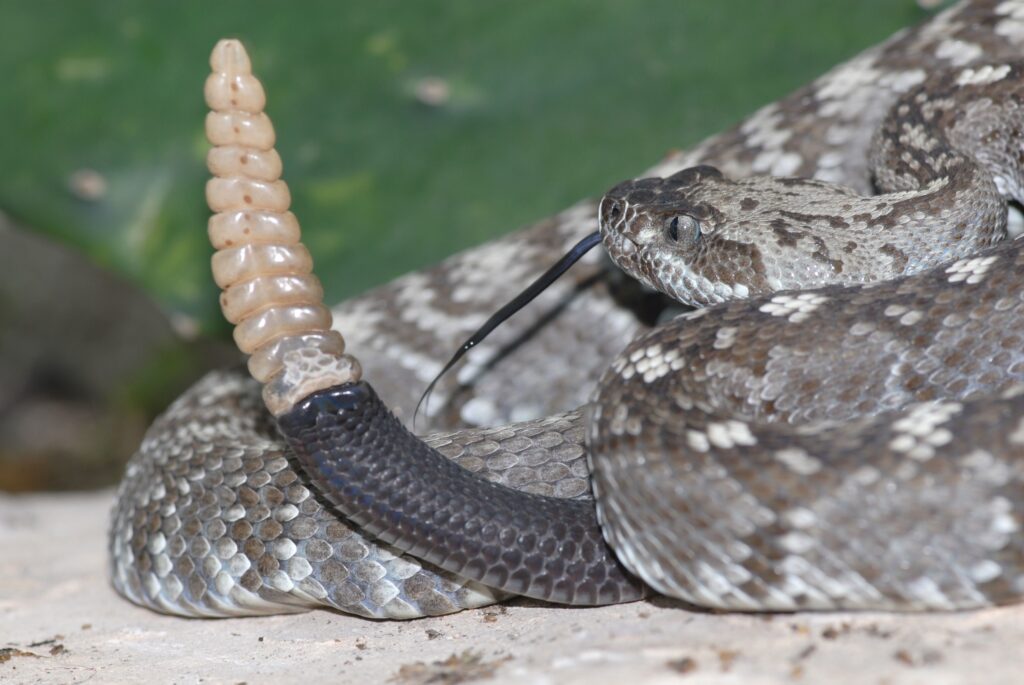
The sound of a rattlesnake rattle is a sound none of us ever want to hear. It is a warning to stay out of the way and that you’re getting too close. We know their rattles get bigger over time, but do rattlesnakes grow a rattle every year?
Here’s what I’ve noticed:
As a general rule, rattlesnakes typically gain two or three new rattle segments each year. Rattlesnakes do not grow an entire rattle every year, just rattle segments, getting 1 new segment each time the snake sheds its skin.
Keep in mind that baby snakes do shed more than adults.
Some people say you can measure a rattlesnake’s age by how many rattles it has. While this is generally true, 1 rattle does not equal one year!
Read on for more tips about the rattlesnake and its rattle growth frequency.
The Rattlesnake’s Rattle
As mentioned before, adult rattlesnakes grow not one, but usually two or three rattle segments per year. This happens whenever it sheds its skin and grows a new one.
When it is time to shed, the rattlesnake will slither around trying to snag the skin on rocks or a tree.
When the skin catches, the snake can just slide right out of it. If you watch this video carefully, you will be able to count the number of rattle segments before and after the snake sheds. It is a fascinating and, if I may say so, satisfying process to witness.
Unlike adult snakes, baby rattlesnakes will most likely shed more than three times a year because they are growing at a more rapid pace and need a larger skin to accommodate their larger body.
Baby rattlesnakes do not actually start with a rattle.
Newborn snakes only have a little nub (often called a button or pre-button) at the end of their tail when they are hatched. When they get to about two weeks old, the snake will grow its very first rattle segment. As mentioned before, baby and juvenile rattlesnakes have to shed more often than a fully grown snake does.
They will shed several times a year until they are a few years old. At this time the growth rate will slow down and shedding will likely decrease to one-three times per year, depending on the availability of food. The more they eat, the more they will grow and the more often they will shed.
The snake will continue to grow new rattle segments each time it sheds its skin. Rather than falling off, rattle segments actually grow and lock into place around each other. This is why the rattle gets larger and louder as the snake ages. They can live anywhere from 10 to 25 years old, so the rattle can get pretty big by the end!
Can You Tell A Rattlesnake’s Age From the Rattle?
The short answer to this question is not exactly. If a rattlesnake were to shed only once a year during its entire lifetime, judging the age of the snake would be fairly simple. However, unless you know exactly when the snake hatched and how many times it shed during its juvenile years, simply counting the number of rattle segments is not very precise.
However, since we can’t know for sure how many times an adult will shed per year, we can’t make reliable approximations of the snake’s age. If you’re close enough to count the rattles on a snake’s tail, you’ve also probably got bigger problems to worry about.
Rattlesnakes: Protected!
As much as many people hate the sight of most snakes, you can actually get in huge trouble for killing one (depending on where you live). There are at least 30 states in the U.S.A. that have snakes of all kinds protected under federal law.
Why you might ask?
Rattlesnakes especially want nothing more than to just be left alone. Yes, they can be dangerous if tampered with or disturbed (even by accident), but they will not typically strike unless they feel threatened.
According to KSL.com, the native aquatic program coordinator of the Division of Wildlife Resources (DWR) said that for this reason, they do not want people killing rattlesnakes indiscriminately. They want to avoid having to put rattlesnakes on the endangered species list, and having a law against hunting them is the best way to see that through.
Because rattlesnakes can be quite dangerous, there are, of course, a few exceptions to the law.
Obviously, if you have encountered a rattlesnake and are in danger of being attacked, you have every right to protect yourself. For example, there are at least six different varieties of rattlesnakes in the state of Utah, the most common species being the Great Basin rattlesnake.
The law states that if you feel your life is being endangered by one of this particular breed of rattlesnake, you have the right to kill it in self-defense.
Hopefully, it will not have to come to that though.
Respecting The Rattle

Rattlesnakes are dangerous and deadly, but they do deserve a level of respect. As mentioned before, rattlesnakes would just prefer to be left alone.
That being the case, it is likely they won’t attack you unless you’re asking for it. Accidents, of course, do happen. If you were to unwittingly stumble into a nest or step on a rattlesnake, chances are it will be startled and attack you immediately.
For this reason, precautionary measures ought to be taken when dealing with rattlesnakes.
When you go out hiking or walking in a rattlesnake-populated area, it is a good idea to prepare accordingly. Wear thick layers and never make them skin tight. Skin-tight layers will make it easier for the snake’s fangs to penetrate your clothing and skin in one bite.
If you wear thick, sturdy hiking boots and loose jeans, you will be well protected. If your boots are sturdy enough the snake won’t stand a chance of getting through them.
If your jeans are hanging loose on your legs, the snake might be able to bite through but it will bite empty air instead of your leg (a preferable outcome, I’m sure). If you happen to spot a snake several feet away, head in the other direction. Don’t risk getting close to it, even if it appears dead.
Unfortunately, snake bites could still happen. If you are hiking and get bitten, don’t panic.
Put as much distance between the snake and yourself as possible, and after doing so, remain still. Increasing your heart rate will only speed up the venom’s journey through your bloodstream. You can wrap the wound in a clean bandage but don’t make it too tight. Instead, let it bleed a little. This should help the venom to leak out some.
Call 911 as soon as possible and try to relax until help arrives.
